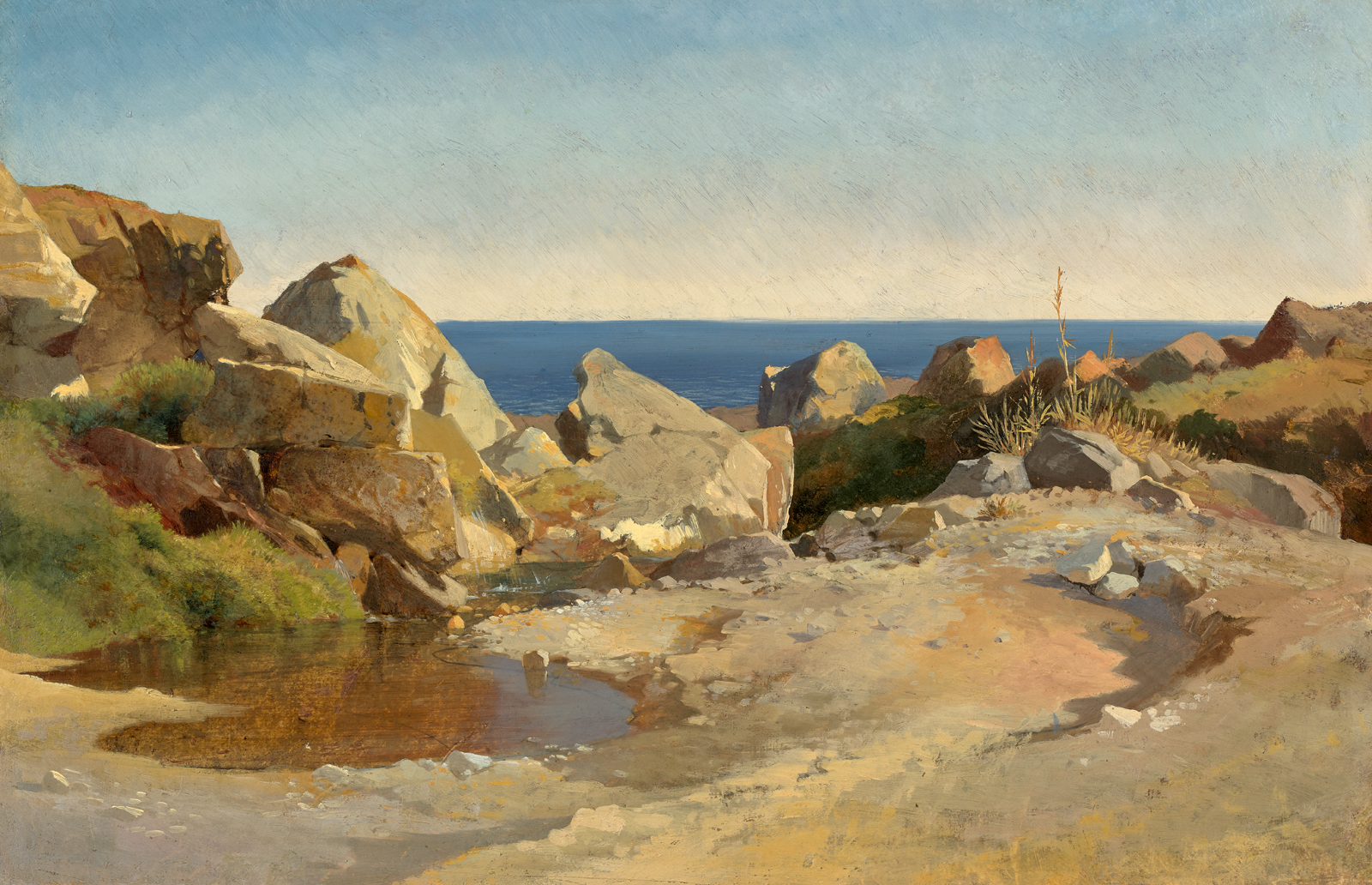Alexandre Calame
(Vevey 1810 - 1864 Menton)
Bords de mer à Cannes - Rocky Shore near Cannes, 1858-60
Oil on cardboard, 30 x 46.5 cm
Provenance:
The artist’s estate
Amélie Calame (the artist’s widow, 1815-1907), Geneva (1865)
By descent to Arthur Calame (the artist’s son, 1843-1919), Geneva (1907)
Marguerite Buscarlet-Calame, Geneva (on the verso the printed inventory label of Arthur Calame’s estate dated 15 April 1922, bearing the hand-written number 289 and signature of Buscarlet-Calame)
Daniel Buscarlet (1898-1988), Geneva (with a typed address label on the verso)
Jean-Marc Buscarlet (with a typed ownership label dated 1988 on the verso)
By descent to a private European collection
Literature:
Paris, Hôtel Drouot, Catalogue de la vente Calame, 17 March 1865, lot. 45
Daniel Buscarlet, Une lignée d’artistes suisses: Müntz-Berger, Alexandre et Arthur Calame, Neuchâtel 1969, p. 73 (according to Anker [see below] the dimensions given are incorrect)
Valentina Anker, Alexandre Calame – Vie et œuvre, catalogue raisonné, Fribourg 1987, p. 445, no. 717 (The present work is illustrated in the catalogue raisonné.The dimensions given are those of a smaller work on canvas measuring 25 x 32.5 cm identified by Anker as lot 292 of the vente Calame, titled Bords de mer à Cannes, while lot 45 of the vente Calame is described as Entrée de Cannes).
I find nature very hard, and struggle to become accustomed to it.[1] (Alexandre Calame)
However critical of his own talents Alexandre Calame may have been, the paintrly virtuosity of his light-filled landscapes – and especially his oil sketches – is unquestionable. In the 1850s, a lung condition obliged him to forgo his trips to high mountain regions. He was compelled to spend time in the South of France where the mild climate benefitted his health. Three visits to the Côte d’Azur are documented – in the years 1853, 1858 and 1860.[2] During these visits he was to produce a large number of oil studies of the Mediterranean coast, landscape views depicting the characteristics of the local vegetation and rock formations. Few, however, were worked up into large-format studio paintings. The landscapes of the Mediterranean region provided Calame with a fresh challenge and inspired the creation of a rich and impressive body of work. Until then, the mountains, lakes and forests of his native Switzerland had been his preferred motifs.
Painted en plein-air, this relatively large, highly finished oil study belongs to a group of studies and sketches after a similar motif executed by Calame in the years 1858-60. Unusual rock formations observed on the coast and in mountainous regions are a recurrent theme in his oeuvre. He was especially interested in depicting the play of light and shadow and identifying the shifts in tone and colour when sunlight illuminated the rough surfaces and outlines of rocks and boulders, emphasizing their volumes and angularity. The massive forms of the rocks are skillfully modelled and their striking shapes stand out against the deep azure of the sea and the cloudless blue sky. Vegetation is sparse. In the foreground, a rock pool reflects the silvery blue of the sky.
Calame never intended to offer his oil sketches for sale but kept them as models to serve as the basis for large-format studio paintings. Most of them remained in his studio until his death. They did not appear on the market in any great number until his estate was dispersed at auction in Paris in 1865. Present-day collectors are attracted by their extraordinary virtuosity and topographical exactitude. The sketches convey a compellingly accurate impression of the atmospheric effects and the quality of light experienced before the motif. Calame’s determination to achieve a high degree of realism in his oil sketches was fundamental to the completion of the magisterial studio landscapes.[3]
In the 1840s, Calame was ranked as one of Switzerland’s leading landscape painters in the company of such names as his teacher François Diday and Wolfgang-Adam Töpffer. He received numerous awards during his lifetime but after his death in 1864, recognition of his work experienced something of a decline. Today, he is regarded as one of the major representatives of the Swiss Romantic heroic tradition in landscape and alpine painting.[4]
[1] Cited after Eugène Rambert, Alexandre Calame: sa vie et son oeuvre; d'après les sources originales, Paris 1884, p. 447.
[2] See Alfred Schreiber-Favre, Alexandre Calame, peintre paysagiste, graveur et lithographe: Ouvrage illustré d'un portrait de l'artiste et de 75 planches en héliogravure, dont 4 en héliochromie et 8 en bichromie, Geneva 1934, p. 29 ; see Valentina Anker, Alexandre Calame – Vie et œuvre, catalogue raisonné, Fribourg 1987, p. 464.
[3] See Alberto de Andrés, Alpine Views. Alexandre Calame and the Swiss Landscape, exhib. cat., Williamstown, Massachusetts, Sterling and Francine Clark Art Institute, New Haven and London 2006, p. 28.
[4] An exhibition of works from the private collection of Asbjorn Lunde was staged at the National Gallery in London in 2011. It featured a large group of paintings by Calame shown in juxtaposition to works by major Northern European painters. The exhibition convincingly demonstrated Calame’s signal importance in early 19th-century European landscape painting. See Forests, Rocks, Torrents; Norwegian and Swiss Landscape Paintings from the Lunde Collection, exhib. cat., London, National Gallery, 2011.

